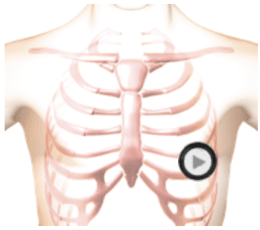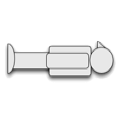Here a fourth heart sound occurs in late diastole just prior to the first heart sound.
The first heart sound is decreased in intensity and the second heart sound is increased in intensity.
The fourth heart sound is produced by an increase in stiffness of the left ventricle due to scar tissue formation. This may be a manifestation of coronary heart disease.
A fourth heart sound can also be caused by a greatly thickened left ventricular wall such as with essential hypertension or aortic stenosis. This is shown in the anatomy video.
A fourth heart sound is never heard with atrial fibrillation because the contraction of the atria is ineffective in this condition.
The fourth heart sound is a low frequency sound best heard with the bell of the stethoscope pressed lightly on the skin of the chest.
Fourth Heart Sound Gallop 107 Audio


Technique

The patient's position should be supine.
Auscultation Tips for Fourth Heart Sound Gallop 107
S1:Reduced intensityS2:Increased intensity
Diastole:S4 present - a low-pitched sound
Sound Wave
Fourth Heart Sound Gallop 107 Video
Authors and Sources
Authors and Reviewers
- ECG heart rhythm modules: Thomas O'Brien.
- ECG monitor simulation developer: Steve Collmann
-
12 Lead Course: Dr. Michael Mazzini, MD.
- Spanish language ECG: Breena R. Taira, MD, MPH
- Medical review: Dr. Jonathan Keroes, MD
- Medical review: Dr. Pedro Azevedo, MD, Cardiology
- Last Update: 11/8/2021
Sources
-
Electrocardiography for Healthcare Professionals, 6th Edition
Kathryn Booth and Thomas O'Brien
ISBN10: 1265013470, ISBN13: 9781265013479
McGraw Hill, 2023 -
Rapid Interpretation of EKG's, Sixth Edition
Dale Dublin
Cover Publishing Company -
EKG Reference Guide
EKG.Academy -
12 Lead EKG for Nurses: Simple Steps to Interpret Rhythms, Arrhythmias, Blocks, Hypertrophy, Infarcts, & Cardiac Drugs
Aaron Reed
Create Space Independent Publishing -
Heart Sounds and Murmurs: A Practical Guide with Audio CD-ROM 3rd Edition
Elsevier-Health Sciences Division
Barbara A. Erickson, PhD, RN, CCRN -
The Virtual Cardiac Patient: A Multimedia Guide to Heart Sounds, Murmurs, EKG
Jonathan Keroes, David Lieberman
Publisher: Lippincott Williams & Wilkin)
ISBN-10: 0781784425; ISBN-13: 978-0781784429 - Project Semilla, UCLA Emergency Medicine, EKG Training Breena R. Taira, MD, MPH
-
ECG Reference Guide
PracticalClinicalSkills.com
Fourth Heart Sound Gallop 107 | Auscultation Cheat Sheet with Sounds & Video | #85